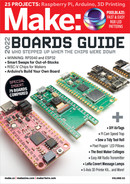
hardware required. The two most popular LED
libraries for Arduino are Adafruit NeoPixel
library and the FastLED library. Make sure
to verify your part numbers before you start
programming to be sure you’re compatible. Both
are excellent choices, depending on your style of
programming, but there’s a lot more information
online about the NeoPixel library, including some
great Adafruit tutorials. One of my favorite places
to get patterns is Tweaking4All, which provides a
great variety in both libraries: makezine.com/go/
tweaking4all.
There are a ton of dedicated LED controller
boards out there that can help you map full video
onto your matrix, program responsive designs, or
do a variety of wacky things, but my favorite is the
Pixelblaze by ElectroMage (Figure
G
) because
it’s easy to get started and it’s pretty powerful!
There’s also a great community online, and it’s
packed with features right out of the box. The
PixelblazeV3 uses an ESP32 and has 12 GPIO
pins for additional inputs (there’s also a tiny Pico
version without the GPIO). You connect it to a
Wi-Fi network and access an interface through
your browser, which allows you to use Javascript
to code your own patterns and access a whole
bunch of existing ones as well (Figure
H
). There
is also a sensor breakout board that has an
onboard microphone, accelerometer, light sensor,
and co-processor that performs audio frequency
analysis, making your interactive LED projects
extremely compact and fast!
Other honorable mentions for best LED drivers
include the WOW Pixel Driver by Elec-Tron, which
has a web interface and ESP8266 support; it’s
available assembled or as a kit (wow.elec-tron.
org). And although it’s discontinued, the Fade
Candy by ScanLime is great for integrating with
programming languages like Processing. I also
like the nLiten Tech Controller used by my pals at
MakeFashion — although I haven’t used it myself,
I have seen great things and it is made to get
started quickly with beautiful effects (nliten.tech).
All of these techniques can give your LED
projects a smart look. Don’t underestimate the
power of a single LED, or the light of a basic strip.
There’s usually no need to for expensive high-
density strips. You’d be surprised at what you can
achieve with some creative diffusion!
LIGHTING TECHNIQUES
It’s best practice in the LED world
to not just put bare LEDs on your
project. You can use a variety of
techniques to make your lighting
projects more interesting:
• You can diffuse light by placing
fabric or other semi-opaque
white materials in front of your
LEDs (Figure
I
); this makes
the individual lights less visible.
The trick with diffusion is getting
distance between your LED and
material. I recommend using
things like plastic bags or sheets,
cotton balls, fabric — get creative!
• Backlighting can be really useful
to highlight an opaque element,
like a sign or PCB. You place LEDs
behind the material and allow light
to spill out on the edge (Figure
J
) .
• You can also try edge lighting:
placing an LED or strip directly
against the edge of a piece of clear
plastic. If the plastic is etched, it
will catch the light and illuminate
your patterns (Figure
K
).
• Other options include reflecting
light off mirrors (Figure
L
), or
refracting it through prisms or
gems (Figure
M
).
I
J
K
L
M
H
G
Adafruit, Dushan Milic, ElectroMage
73
make.co
M83_070-75_SquishyLee_F1.indd 73M83_070-75_SquishyLee_F1.indd 73 10/10/22 3:51 PM10/10/22 3:51 PM
..................Content has been hidden....................
You can't read the all page of ebook, please click here login for view all page.
